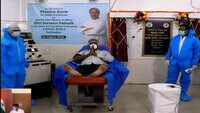
SRINAGAR: Jammu & Kashmir, which had seen outbound movement of 40,000 non-Kashmiri migrant workers starting May 19 on account of the Covid-19 crisis, has reported reverse migration of around 25,000 labourers in recent weeks.
Senior officials in the home ministry and J&K administration said the return of migrant labour, facilitated via 25 Shramik special trains run from Katra and three chartered flights, is thanks to the efforts of J&K government to restart development works in all areas other than Covid-19 hotspots. “While the rural economy is in full bloom with a hopefully bumper fruit season beckoning, other activities, including wage labour works, public works and large projects are revving back to action. Similarly, private industries and contractors are remobilising labour and there is now a push for reverse migration,” said an officer.
The labourers are flying back into J&K from various states such as Bihar, since air route is preferred due to limited operation of trains. “While some employers take care of the airfare, many migrant workers are spending own money to reach J&K as they have work options here,” an officer told TOI.
Of course, with J&K being the only jurisdiction in the country that mandatorily conducts RT-PCR tests on all arriving persons or returnees, each of these returning migrant workers is tested for Covid at the entry point itself, be it airports, railway stations or the highways. Sampling and testing set-ups have been created at the entry points and all returnees must shift to administrative quarantine centres till the test results are received in the next 24-48 hours.
Till now, 3.2 lakh persons, including 60,000 returning migrants (both Kashmiris working in other states and non-Kashmiris working in J&K) who have come into J&K have been tested.
Thanks to its 100% testing protocol for arriving/returning passengers, over 4,200 positive cases could be detected at J&K entry points and isolated. This, a senior J&K official told TOI, has prevented an estimated 20,000 potential cases, assuming that a positive person could have, on an average, infected four others.
Senior officials in the home ministry and J&K administration said the return of migrant labour, facilitated via 25 Shramik special trains run from Katra and three chartered flights, is thanks to the efforts of J&K government to restart development works in all areas other than Covid-19 hotspots. “While the rural economy is in full bloom with a hopefully bumper fruit season beckoning, other activities, including wage labour works, public works and large projects are revving back to action. Similarly, private industries and contractors are remobilising labour and there is now a push for reverse migration,” said an officer.
The labourers are flying back into J&K from various states such as Bihar, since air route is preferred due to limited operation of trains. “While some employers take care of the airfare, many migrant workers are spending own money to reach J&K as they have work options here,” an officer told TOI.
Of course, with J&K being the only jurisdiction in the country that mandatorily conducts RT-PCR tests on all arriving persons or returnees, each of these returning migrant workers is tested for Covid at the entry point itself, be it airports, railway stations or the highways. Sampling and testing set-ups have been created at the entry points and all returnees must shift to administrative quarantine centres till the test results are received in the next 24-48 hours.
Till now, 3.2 lakh persons, including 60,000 returning migrants (both Kashmiris working in other states and non-Kashmiris working in J&K) who have come into J&K have been tested.
Thanks to its 100% testing protocol for arriving/returning passengers, over 4,200 positive cases could be detected at J&K entry points and isolated. This, a senior J&K official told TOI, has prevented an estimated 20,000 potential cases, assuming that a positive person could have, on an average, infected four others.
Download
The Times of India News App for Latest India News

Coronavirus outbreak
Trending Topics
LATEST VIDEOS
India
 UPSC result 2019: Pratibha Verma from UP tops among women candidates
UPSC result 2019: Pratibha Verma from UP tops among women candidates  Vice President Venkaiah Naidu performs puja at his residence on occasion of Ram Temple bhoomi pujan
Vice President Venkaiah Naidu performs puja at his residence on occasion of Ram Temple bhoomi pujan  Bhoomi Pujan: Celebrations across Bhopal, RAF deployed at sensitive locations
Bhoomi Pujan: Celebrations across Bhopal, RAF deployed at sensitive locations  Hindutva has won today: Asaduddin Owaisi on PM Narendra Modi laying foundation of Ram Temple
Hindutva has won today: Asaduddin Owaisi on PM Narendra Modi laying foundation of Ram Temple  Nation celebrates Foundation laying ceremony of Ram temple in Ayodhya with 'deepotsav'
Nation celebrates Foundation laying ceremony of Ram temple in Ayodhya with 'deepotsav'  Covid-19: Odisha CM inaugurates two plasma therapy facilities
Covid-19: Odisha CM inaugurates two plasma therapy facilities
More from TOI
Navbharat Times
Featured Today in Travel
Quick Links
Coronavirus in MumbaiCoronavirus in KolkataCoronavirus in HyderabadCoronavirus in DelhiCoronavirus in BangaloreCoronavirus symptomsCoronavirus in IndiaWhat is CoronavirusCoronavirus NewsSolar EclipseNPRWhat is NRCCAB BillCAB and NRCRTI BillPodcast newsLok SabhaShiv SenaYSRCPCongressBJP newsUIDAIIndian ArmyISRO newsSupreme Court
Get the app



